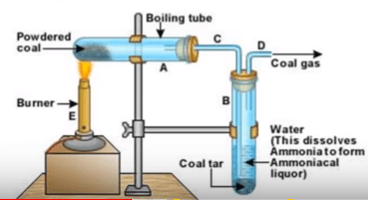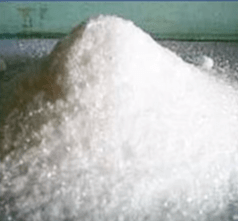Coal and Petroleum Class 8 Science Chapter 5 as per NCERT Book used in CBSE and other Schools. The lesson covers the complete explanation of class 8 Chapter 5 Coal and Petroleum. Topics covered are types of natural resources, fossil fuels, destructive distillation, energy and environment. The lesson covers all important questions based on coal and petroleum. NCERT solutions to book questions have also been provided for convenience of the students.

In this chapter we will learn about the properties, formation and uses of coal and petroleum.
The topics that we will discuss in this lesson are:
- Basic introduction
- Types of natural resources.
- Fossil fuels
- Destructive distillation
- Energy and Environment
Before we start discussing, let us have a look at energy.
See Video:
Energy is the ability to do any work. We cannot do any work without energy or power. We can say that the capacity to do any work is called energy. There are different forms of energy and all forms of energy are stored in energy sources in different ways. This energy source is used in daily routine tasks. For example: Bulb. When we turn the bulb on, energy comes in the form of heat and light. That is the reason we are unable to touch the bulb from outside as it gets very hot. The electrical energy of the bulb gets converted into heat and light. Thus, we need a cloth to hold it. Energy is always conserved or constant.
We can say that energy can neither be created nor destroyed, but it can be conserved. Energy is converted from one form to another form. For example: Solar energy. We get energy from sun in the form of heat and light. It gets stored in different sources and can be used everyday.
Sources of Energy – Renewable and non renewable
The different sources of energy are as follows:
Biomass: Any substance which is obtained from plants or animals or its refuse is known as biomass.
Hydelpower: It means dams. Dams are used to store river water in a reservoir.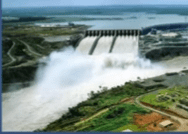
The water released from the reservoir flows through a turbine, spinning it, which in turn activates a generator to produce electricity.
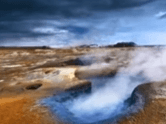 Geothermal: Geothermal energy is obtained from earth. It is clean and sustainable. There are hot spots (have elements which continuously degrades) which are present beneath the earth and these spots degrade and its mass is automatically converted into energy.
Geothermal: Geothermal energy is obtained from earth. It is clean and sustainable. There are hot spots (have elements which continuously degrades) which are present beneath the earth and these spots degrade and its mass is automatically converted into energy.

Wind energy:
The energy obtained from wind mills.

Solar energy: The energy obtained from sun.
The sun’s light is used as energy and due to this energy we can see things during the day.

Petrol: It is used in vehicles. It gives energy which helps in running of vehicles.
 Coal: Energy is produced when coal is burned. This energy is used in engines.
Coal: Energy is produced when coal is burned. This energy is used in engines.
Nuclear energy: Nuclear energy is produced in nuclear power stations and this energy can be used for different processes.
Natural sources of energy
Nature provides us energy. For example. The air we breathe, the water we drink, the food, sunlight, minerals, etc.
Man-made sources of energy
The resources which are made by man are known as man-made sources of energy.
For example: The natural wind is of no use until it is processed to get wind energy with the help of wind mills.
Natural resources of energy are further categorized into two types:
- Renewable resources
- Non Renewable resources
Renewable resources of energy
The substances which are easily renewed are renewable resources of energy. These substances will not finish easily and last for a long time.
For example: Sunlight, water, air.
These are non exhaustible like water.
Non Renewable resources of energy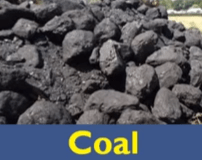
The substances which cannot be easily renewed are called non renewable sources of energy. If these substances get exhausted, they will take a lot of time, or even years to form again.
For example: Fossils fuel.
These resources are exhaustible like petrol.
Q. Here the question arises, can sunlight get exhausted by human activities?
Answer: Sunlight is an ultimate source of energy and it is free of cost. It cannot be exhausted by human activities as it is produced by the natural process of fusion inside the sun. Due to this nuclear fusion, extremely large amount of energy is produced which comes in the form of sunlight.
Time to check your knowledge by answering the following questions-
Q. Name some inexhaustible substances other than sunlight and air.
Answer: Some more inexhaustible substances other than sunlight and air are as follows –
Sand, Wind energy, Geothermal energy, Tidal energy.
Q. Which fuel out of the following is used for running vehicles?
(a) Wood
(b) Coal
(c) Diesel
(d) Charcoal
Answer: (c) Diesel
Q. Which of the following is a natural resource of energy?
(a) Tea
(b) Cooked food
(c) Air
(d) Toffee
Answer: (c) Air
Q. Inexhaustible natural resources are known as ________?
(a) limited
(b) unlimited
(c) scarce
(d) not present
Answer: (b) Unlimited
Q. Which of the following is an exhaustible natural resource of energy?
(a) Air
(b) Water
(c) Soil
(d) coal
Answer: (b) Water
Fossil fuels
Many years ago, plants and animals got buried down underneath the earth and turned into fossils fuels due to the act of high pressure and temperature.
There are three types of fossils as follows-
- Coal
- Petroleum
- Natural gas
Q. Why are fossil fuels called exhaustible natural resource? Explain.
Answer: Fossil fuels are present in limited quantity in nature. They can be exhausted by human activities. So, fossil fuels are called exhaustible natural resources.
Q. Can air, water and soil be exhausted by human activities?
Answer: No, air, water and soil cannot be exhausted by human activities.
Q. Is water a limitless source?
Answer: Yes, water is a limitless source. But by unwise use, sources of water can finish.
Let us discuss coal in detail-
Coal
- It a black colored hard substance. It is a sedimentary rock that burns.
- It is composed of carbon, hydrogen, oxygen and minor amounts of sulphur and nitrogen.
- The major types of coal are Anthracite, bituminous, lignite.
- Anthracite is the hardest coal with higher carbon concentration and energy.
- Lignite is the softest coal. It has low carbon concentration but high oxygen and hydrogen concentrations.
- Bituminous has moderate hardness and concentration of carbon.
Formation of Coal
- Many years ago, the dense forests present in low lying areas of wetlands got buried down underneath the soil due to natural calamities like flooding, earthquakes, etc.
- They got compressed with time, as more soil deposited on them.
- They descended deeper and deeper and encountered high temperature and pressure.
- These dead plants slowly got converted into coal under high temperature and pressure.
- The main constituent of coal is carbon, therefore, this process of conversion of dead plants into coal is termed as carbonization
Q. Describe how coal is formed from dead vegetation? What is this called?
Answer: Written above.
Types of Coal
The different types of coal are as follows-
Peat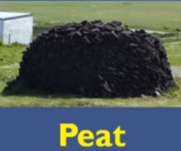
Peat is light brown in color. It has 60% carbon content. It produces less heat, but produces more smoke on burning. Its calorific value is 10 to 15 kJ/g.
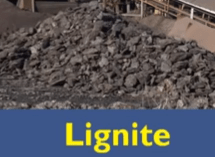
Lignite
Lignite is brown in color. It contains 70% of carbon. It is known as soft coal. Its calorific value is 15 to 20 kJ/g.
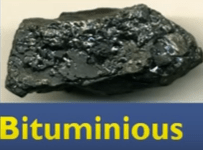
Bituminous coal
Bituminous coal contains 80% of carbon. It is the common household coal. It is compact and black. On burning, it produces more heat than peat and lignite. Its calorific value is 30 to 35 kJ/g.
Anthracite coal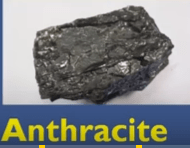
It contains 90% of carbon. It is the hardest coal, containing maximum carbon. It burns with difficulty as it contains very low volatile matter. Therefore, it is not used for household purposes. It is mainly used for industrial purposes. Its calorific value is 28 to 30 kJ/g.
Hence, we can say, the more the carbon content more best is that coal. Like Anthracite. It is best coal, but it is very expensive.
Destructive distillation
When any substance is heated in the absence of air and forms a number of products, the process is known as destructive distillation of coal. As we know that coal contains a number of elements such as carbon, hydrogen, oxygen, nitrogen and sulphur.
The products which are obtained by the process of destructive distillation are:
- Coke
- Ammoniacal liquor
- Coal tar
- Coal gas
Coke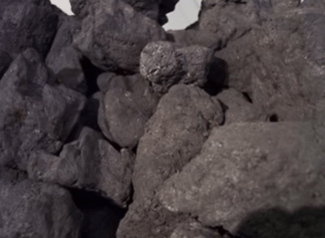
When powdered coal is heated in distillation apparatus, the substance which is left after heating it is known as coke. It contains 98 % carbon. It is porous, tough, black and the purest form of coal. Like charcoal, it burns without smoke. It is a very good fuel. It is used as a reducing agent in the process of extraction of metals from their ores(metallurgy). It is also used in making fuel gases like water gas and producer gas.
For example: ZnO (Zinc oxide) + C (carbon) → Zn + CO
Carbon is used a reducing agent as it helps in separation of Zinc oxide.
Ammoniacal liquor
It is converted into ammonium sulphate by absorbing dilute sulphuric acid and ammonium sulphate. It is an excellent fertilizer.
For example:
NH4OH (ammoniacal liquor) + H2SO4 (sulphuric acid) → (NH4)2 SO4 (ammonium sulphate)
Coal tar (liquid)
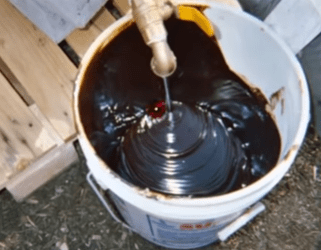
Coal tar is a mixture of different carbon compounds. It is obtained after heating powdered coal. It is a thick and black liquid with unpleasant smell. It is used for surfacing road and also as a source of different aromatic compounds. The fractional distillation of coal tar gives many chemical substances which are used in the preparation of dyes, explosives, paints, synthetics fibers, drugs, and pesticides. Examples of these chemical substances are benzene, toluene, phenol and aniline. Naphthalene balls used to repel moth and other insects are also obtained from coal tar.
These days, bitumen, a petroleum product is used in place of coal tar for metalling the roads.
Coal Gas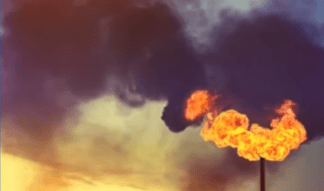
Coal gas is mainly a mixture of hydrogen, methane and carbon monoxide. The gases present in coal gas are combustible (produces heat on burning) and hence, it is an excellent fuel. It has high calorific value. It was used for lighting houses, factories and streets.
Natural gas
It is a mixture of alkanes, which contain 80% methane (CH4), 7% ethane(C2H6), 6% propane(C3H8), and 4% butane(C4H10). It is formed from dead organisms which buried under the earth thousands of years ago and these organisms decompose in the absence of air. For example: CNG.
CNG (Compressed Natural Gas)
CNG is used in the form of a natural gas. Its main constituent is methane.
CNG is very efficient. It produces less smoke and does not produce harmful gases. It can be easily burn. It can be easily handle. It is used as a fuel in vehicles because it is less polluting or cleaner fuel. It is used in manufacturing of chemicals and fertilizers.
LPG (Liquified Petroleum Gas)
The natural gas is also used in the form of Liquefied Petroleum Gas. Its main component is butane and propane.
It is used in filling cylinder and for cooking purpose. It is also used as an industrial fuel.
Petroleum
It is a dark, oily liquid with an unpleasant smell. The term ‘petroleum’ has been derived from the Latin words: ‘petra’- which means rock and ‘oleum’- which means oil.
Formation of Petroleum
Many organisms were living in the seas. When these organisms died, their bodies got settled at the bottom of the sea. Then, these got covered by layers of sand and clay. After millions of years, it got converted into petroleum due to the absence of air, temperature and pressure.
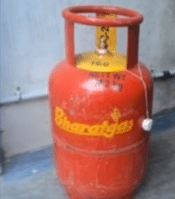
Petroleum covers the following-
Liquified Petroleum Gas(LPG)
It is used as a fuel in industry and home. It is used for cooking purpose.
Petrol
It is used in automobiles and as a solvent for dry cleaning.
Kerosene
It is used in stoves and lamps, etc.
Diesel
It is used as a fuel in vehicles and generators.
Lubricating Oil
It is used in lubrication or it is used to smoothen things like-
Paraffin Wax: It is use in ointment, candles, Vaseline etc.
Bitumen: It is used for making paints and surfacing roads.
Refining of Petroleum/ Fractional distillation
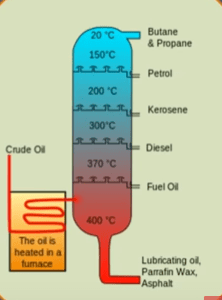
The process by which petroleum can be separated from the various components is known as refining of petroleum. The components from which petroleum is separated have different boiling points. (Boiling Point is the point at which liquid is converted into gas on heating).
Crude oil is heated in a furnace at around 400 degree Celsius. Then, it is added into the fractionating column. At the bottom of the fractionating column, crude oil with the highest boiling point is collected and the oil with lowest boiling point is collected at the top of the fractionating column.
Complete combustion of hydrocarbons leads to the formation of carbon dioxide and water. Incomplete combustion of hydrocarbons leads to the formation of carbon monoxide and water. Carbon dioxide and carbon monoxide cause pollution in the environment.
The test which is used to determine the amount of carbon monoxide in vehicle’s exhaust gas is known as emission test. Gas analyzer is used in detection of carbon monoxide.
Q. What is cracking?
Answer: The process in which higher alkanes are heated in sufficient high temperatures and in absence of oxygen to form lower hydrocarbons is called cracking.
Energy and Environment
Q. Why energy affects the environment?
Answer:
1. Energy affects the environment due to the increase in industries or we can say that with increasing rate of industrialization.
2. Environment is affected due to the increasing demand for luxurious items like clothes, cars, laptops etc. For these luxurious items, we need a lot of industries. These industries produces a lot of smoke and harmful substances are suspended in the air. Therefore, it affects our health and environment.
3. Increase in demand for entertainment facilities like laptops and television. Due to this, a lot of industries are setup which directly affect the environment including atmosphere, air and hydrosphere.
4. Increase in demand for various modern techniques of agriculture including pesticides and fertilizers leads to harm to the environment.
Q. Why is burning of fuels harmful?
Answer: The first harm of burning fossil fuels is the damage that they cause to the health of our population. This is the fact that we need clean air for good health. The main reason why fossil fuels are bad for our health is that when we burn fossil fuels, it releases a number of extremely harmful gases, such as carbon dioxide and monoxide, sulphur oxides, nitrogen oxides, and hydrocarbons. Their combination released into the atmosphere creates smog. This smog is very harmful.
Limitations of Natural Resources
There are a lot of natural resources which are exhaustible such as fossil fuels, forests, minerals, etc. Fossils fuels like coal, petroleum, etc. take millions of years to get converted into fuels from dead bodies. Currently, their demand is so high that after few hundred years, there will be scarcity of these resources.
Pollution is caused when fossil fuel is burned. These fuels are responsible for global warming.
Global warming is defined as an increase in carbon dioxide in the air. This carbon dioxide traps the infrared rays which come from sunlight. If carbon dioxide increases, thereby infrared rays increase and due to this, the temperature of the Earth increases and causes global warming. Due to global warming, polar ice caps can melt and cause floods or we can say that our ecological balance can get disturbed.
Therefore, it is important to use these natural resources wisely and carefully.
Preventive measures to save fuel
Some preventive measures to save fuels as given by Petroleum Conservation Research Association(PCRA) are as follows-
- We should drive vehicles at a constant and moderate speed in order to use lesser fuel.
- We should switch the engine off at traffic lights or at a place where we have to wait.
- We should ensure that the pressure of tyres in our vehicle is accurate, in order to use lesser fuel.
- We should ensure regular maintenance of our vehicles.
Multiple Choice Questions
Choose the correct answer out of the given options-
1. Water is a ________
a. Natural substance
b. Man made substance
c. Both of these
d. None of these
Answer: (a) Natural substance
2. What happens when coal burns in air?
a. Carbon dioxide is formed
b. Sulphur dioxide is formed
c. Carbon monoxide is formed
d. Hydrogen gas is formed
Answer: (a) Carbon dioxide is formed
3. Which is the purest form of carbon?
a. Coal
b. Charcoal
c. Coke
d. All of these
Answer: (c) coke
4. How many substances does coal tar contain?
a. 300 substances
b. 400 substances
c. 200 substances
d. 100 substances
Answer: (c) 200 substances
5. The first oil well was drilled by which country?
a. USA
b. USSR
c. UK
d. India
Answer: (a) USA
6. What is the full form of PCRA?
a. Public Conservations Research Association
b. Petroleum Conservation Research Association
c. Public Council of Research Association
d. Partial Counting of remaining Amendment
Answer: (b) Petroleum Conservation Research Association
7. Which of the following is an example of fossil fuel?
a. Wood
b. Animal waste
c. Coal
d. All of these
Answer: (c) Coal
8. Which of the following is natural resource?
a. Car
b. Bus
c. Water
d. Parks
Answer: (c) water
9. Which of the following is a manmade resource?
a. Air
b. Water
c. Soil
d. wind mill
Answer: (d) wind mill
10. Which of the following is obtained from coal tar ?
a. Petrol
b. Coke
c. Air
d. Naphthalene balls
Answer: (d) Naphthalene balls
Q. What is destructive distillation?
Answer: When coal is heated without air, it does not burn but produces many by-products. This process of heating coal in the absence of air is called destructive distillation of coal. The main products formed by this process are:
coke
coal tar
amino acid liquor
coal gas
The destructive distillation of coal can be carried out in the laboratory.
Q. Name some places in India where oil is found?
Answer: The places in North-Eastern India where oil is found are as follows-
Assam, Digboi (oldest field, 1866), Naharkatiya, Moran, Rudrasagar, Galeki, Hugrijan, Angui and Lakwa fields.
In Western India, oil is found at the following places-
In Gujarat important fields are:
Ankleshwar (largest field in the Khambhat Basin), Kalol, Navagam, Kosamba, Barkol, Dholka, Mehsana, Kadi and Ahmedabad.
Q. What is the name of coal which contains a minimum percentage of carbon?
Answer: Peat coal contains 60% carbon which is the minimum percentage of carbon.
NCERT Book Solutions
Q. What are the advantages of CNG and LPG as fuels?
Answer: The advantages of using Compressed Natural Gas (CNG) and Liquified Petroleum Gas (LPG) as fuels are:
(i) They can be burnt directly.
(ii) They can be transported easily through pipelines.
(iii) They are clean fuels and do not give smoke when burnt.
(iv) They give a lot of heat energy when burnt.
Q. Name the petroleum product used for surfacing of roads?
Answer: Bitumen, a petroleum product, is used for surfacing roads.
Fill in the banks.
1. Fossil fuels are ________, ________ and _________.
2. Process of separation of different constituents from petroleum is called _________.
3. Least polluting fuel for vehicles is __________.
Answer:
(a) Fossil fuels are coal, petroleum and natural gas.
(b) Process of separation of different constituents from petroleum is called refining.
(c) Least polluting fuel for vehicles is Compressed Natural Gas (CNG).
Q. Mark the below statements as True/False?
- Fossil fuels can be made in the laboratory. (True / False)
- CNG is more polluting fuel than petrol. (True / False)
- Coke is almost pure form of carbon. (True / False)
- Coal tar is a mixture of various substances. (True / False)
- Kerosene is not a fossil fuel. (True / False)
Answer:
1. Fossil fuels can be made in the laboratory. (False)
2. CNG is more polluting fuel than petrol. (False)
3. Coke is almost pure form of carbon. (True)
4. Coal tar is a mixture of various substances. (True)
5. Kerosene is not a fossil fuel. (False)
Q. Explain why fossil fuels are exhaustible natural resources?
Answer: Fossil fuels need millions of years to form from the dead vegetation and animals that get buried deep inside the Earth. They require high temperature and pressure for their formation and this process cannot be provided in the laboratory. Thus, fossils are limited. Therefore, the use of fossil fuels at this rate will lead to their exhaustion.
Q. What are the characteristics and uses of coke?
Answer: The Characteristics of coke are as follows:
(i) Tough
(ii) Porous
(iii) Black in colour
Uses of coke:
(i) It is used in manufacturing of steel.
(ii) It is used in the extraction of metals (as a reducing agent).
Q. What is a fuel? What are the characteristics of a good fuel?
Answer: A fuel is a form of matter, that is used to produce heat energy or power energy.
The characteristics of a good fuel are:
- It must be easily available.
- It has low cost.
- It should be clean and odorless.
- It should be easily transportable.
- It should produce more energy in proportion to its mass.
- It should leave very little ash after burning.
Q. What are hydrocarbons?
Answer: The compounds of carbon and hydrogen are called hydrocarbon.
Q. Define petrochemicals?
Answer: Petrochemicals are those substances which are obtained from petroleum and natural gas. These are used in the manufacture of detergents, fibres, polythene, etc.
Q. What is the name of the products from which plastic is formed?
Answer: Petroleum.
Question: What is the difference between exhaustible and inexhaustible resources?
Answer: The resources which are present in unlimited quantity in nature and are not likely to be exhausted by human activities are known as Inexhaustible Resources. For Example: Sunlight, air.
The resources which are found in a limited quantity in nature are known as Exhaustible resources. They can be exhausted by human activities. Example of these resources is Forests, Minerals, Coal, Petroleum, Naturals Gas.
